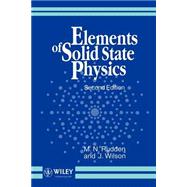
What is included with this book?
Michael N. Rudden and John Wilson are the authors of Elements of Solid State Physics, 2nd Edition, published by Wiley.
| Preface to First Edition | ix | (2) | |||
| Preface to Second Edition | xi | (2) | |||
| Prologue | xiii | ||||
|
1 | (32) | |||
|
2 | (4) | |||
|
6 | (2) | |||
|
8 | (5) | |||
|
13 | (4) | |||
|
17 | (2) | |||
|
19 | (1) | |||
|
20 | (2) | |||
|
22 | (8) | |||
|
30 | (1) | |||
|
30 | (3) | |||
|
33 | (46) | |||
|
34 | (1) | |||
|
35 | (4) | |||
|
38 | (1) | |||
|
39 | (3) | |||
|
39 | (2) | |||
|
41 | (1) | |||
|
41 | (1) | |||
|
42 | (1) | |||
|
42 | (3) | |||
|
45 | (2) | |||
|
47 | (4) | |||
|
48 | (1) | |||
|
49 | (2) | |||
|
51 | (7) | |||
|
53 | (2) | |||
|
55 | (2) | |||
|
57 | (1) | |||
|
57 | (1) | |||
|
58 | (1) | |||
|
58 | (6) | |||
|
58 | (1) | |||
|
59 | (3) | |||
|
62 | (1) | |||
|
63 | (1) | |||
|
64 | (4) | |||
|
66 | (1) | |||
|
66 | (2) | |||
|
68 | (1) | |||
|
68 | (8) | |||
|
76 | (1) | |||
|
76 | (3) | |||
|
79 | (38) | |||
|
80 | (1) | |||
|
81 | (6) | |||
|
82 | (3) | |||
|
85 | (2) | |||
|
87 | (5) | |||
|
87 | (1) | |||
|
88 | (1) | |||
|
88 | (3) | |||
|
91 | (1) | |||
|
92 | (7) | |||
|
94 | (5) | |||
|
99 | (12) | |||
|
102 | (1) | |||
|
103 | (1) | |||
|
103 | (6) | |||
|
109 | (2) | |||
|
111 | (2) | |||
|
113 | (1) | |||
|
114 | (3) | |||
|
117 | (30) | |||
|
117 | (4) | |||
|
118 | (1) | |||
|
119 | (2) | |||
|
121 | (3) | |||
|
124 | (3) | |||
|
127 | (1) | |||
|
128 | (7) | |||
|
128 | (3) | |||
|
131 | (3) | |||
|
134 | (1) | |||
|
135 | (3) | |||
|
138 | (3) | |||
|
141 | (3) | |||
|
144 | (1) | |||
|
145 | (1) | |||
|
145 | (2) | |||
|
147 | (36) | |||
|
147 | (11) | |||
|
147 | (1) | |||
|
148 | (3) | |||
|
151 | (5) | |||
|
156 | (2) | |||
|
158 | (4) | |||
|
158 | (1) | |||
|
159 | (3) | |||
|
162 | (3) | |||
|
165 | (4) | |||
|
169 | (9) | |||
|
172 | (6) | |||
|
178 | (2) | |||
|
180 | (1) | |||
|
181 | (2) | |||
|
183 | (58) | |||
|
183 | (6) | |||
|
189 | (5) | |||
|
194 | (9) | |||
|
194 | (3) | |||
|
197 | (2) | |||
|
199 | (4) | |||
|
203 | (4) | |||
|
204 | (1) | |||
|
204 | (3) | |||
|
207 | (3) | |||
|
210 | (1) | |||
|
211 | (1) | |||
|
212 | (8) | |||
|
214 | (1) | |||
|
215 | (1) | |||
|
216 | (3) | |||
|
219 | (1) | |||
|
220 | (6) | |||
|
221 | (2) | |||
|
223 | (3) | |||
|
226 | (12) | |||
|
226 | (2) | |||
|
228 | (3) | |||
|
231 | (7) | |||
|
238 | (1) | |||
|
239 | (2) | |||
| Suggested Reading List | 241 | (4) | |||
| Discussion Questions | 245 | (4) | |||
| Answers to Problems | 249 | (4) | |||
| Appendices | 253 | (8) | |||
| Appendix 1 Properties of Semiconducting Materials (at 300 K) | 253 | (2) | |||
| Appendix 2 SI Units and Values of Physical Quantities | 255 | (2) | |||
| Appendix 3 Motion of an Electron in a Periodic Lattice: The Kronig-Penney Model | 257 | (4) | |||
| Index | 261 |
The New copy of this book will include any supplemental materials advertised. Please check the title of the book to determine if it should include any access cards, study guides, lab manuals, CDs, etc.
The Used, Rental and eBook copies of this book are not guaranteed to include any supplemental materials. Typically, only the book itself is included. This is true even if the title states it includes any access cards, study guides, lab manuals, CDs, etc.